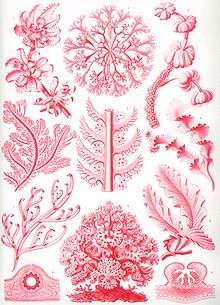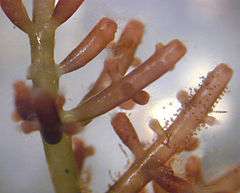Florideae
Florideophyceae, demoted to subclass Florideae in some classification systems, is a class of red algae, estimated to make up about 95% of all known red algae species.[3] It is sometimes merged with the Bangiophyceae into the Rhodophyceae, leaving the subclass Florideae in use.[4] They were once thought to be the only algae to bear pit connections,[5] but these have since been found in the filamentous stage of the Bangiaceae.[6]
| Florideae | |
|---|---|
 | |
| "Florideae" from Ernst Haeckel's Kunstformen der Natur, 1904 | |
| Scientific classification | |
| (unranked): | Archaeplastida |
| Division: | Rhodophyta |
| Subdivision: | Eurhodophytina |
| Class: | Florideophyceae Cronquist, 1960[2] |
| Subgroups | |
"Florideophyceae" is still used by some authorities.[7]
Once thought only to exhibit apical growth, some genera grow by intercalary growth.[6] Most, but not all, genera have three phases to the life cycle.[6]
Classification

There are various classification schemes; see red algae. One option is to use the following:
Subclass Hildenbrandiophycidae
Subclass Nemaliophycidae
- Acrochaetiales
- Balbianiales
- Balliales
- Batrachospermales
- Colaconematales
- Nemaliales
- Palmariales
Subclass Corallinophycidae
The subclass Corallinophycidae was introduced in 2007.[8]
Subclass Ahnfeltiophycidae
- Ahnfeltiales
- Pihiellales
Subclass Rhodymeniophycidae
- Bonnemaisoniales
- Ceramiales
- Gelidiales
- Gigartinales
- Gracilariales
- Halymeniales
- Nemastomatales
- Peyssonneliales
- Plocamiales
- Rhodymeniales
According to molecular clock analysis, Florideophyceae diverged from other red algae about 943 (817–1,049) million years ago. It split into Hildenbrandiophycidae ca. 781 (681–879) mya, Nemaliophycidae ca. 661 (597–736) mya and Corallinophycidae ca. 579 (543–617) mya, and ca. 508 (442–580) mya the split between Ahnfeltiophycidae and Rhodymeniophycidae occurred.[9]
References
- Parfrey, Laura Wegener; Lahr, Daniel J. G.; Knoll, Andrew H.; Katz, Laura A. (16 August 2011). "Estimating the timing of early eukaryotic diversification with multigene molecular clocks". Proceedings of the National Academy of Sciences of the United States of America. 108 (33): 13624–13629. Bibcode:2011PNAS..10813624P. doi:10.1073/pnas.1110633108. PMC 3158185. PMID 21810989.
- Cronquist, A. (1960). "The divisions and classes of plants". The Botanical Review. 26 (4): 425–482. doi:10.1007/BF02940572.
- Brodie, J; Zuccarello, GC (2006). "20: Systematics of the species. Rich Algae: Red Algal Classification Phylogeny and Speciation". In Hodkinson, Trevor R.; Parnell, John A.N. (eds.). Reconstructing the tree of life : taxonomy and systematics of species rich taxa. Boca Raton, Fla.: Taylor & Francis. pp. 323–336. ISBN 978-0-8493-9579-6.
- "Search - The Encyclopedia of Earth". www.eoearth.org. Retrieved 23 April 2018.
- Dawes, C. J.; Scott, F. M.; Bowler, E. (1961). "A Light- and Electron-Microscopic Survey of Algal Cell Walls. I. Phaeophyta and Rhodophyta". American Journal of Botany. 48 (10): 925–934. doi:10.2307/2439535. JSTOR 2439535.
- Lee, R.E. (2008). Phycology, 4th edition. Cambridge University Press. ISBN 978-0-521-63883-8.
- Juliet Brodie; Jane Lewis (PhD) (2007). Unravelling the algae: the past, present, and future of algal systematics. CRC Press. pp. 109–. ISBN 978-0-8493-7989-5. Retrieved 31 January 2011.
- Le Gall L, Saunders GW (June 2007). "A nuclear phylogeny of the Florideophyceae (Rhodophyta) inferred from combined EF2, small subunit and large subunit ribosomal DNA: establishing the new red algal subclass Corallinophycidae". Mol. Phylogenet. Evol. 43 (3): 1118–30. doi:10.1016/j.ympev.2006.11.012. PMID 17197199.
- Divergence time estimates and the evolution of major lineages in the florideophyte red algae - Nature